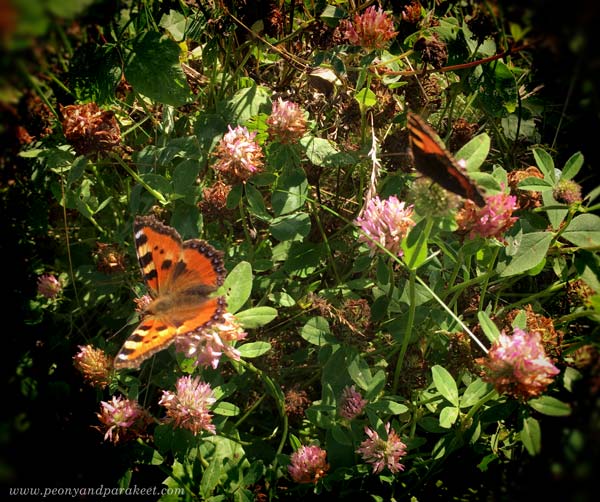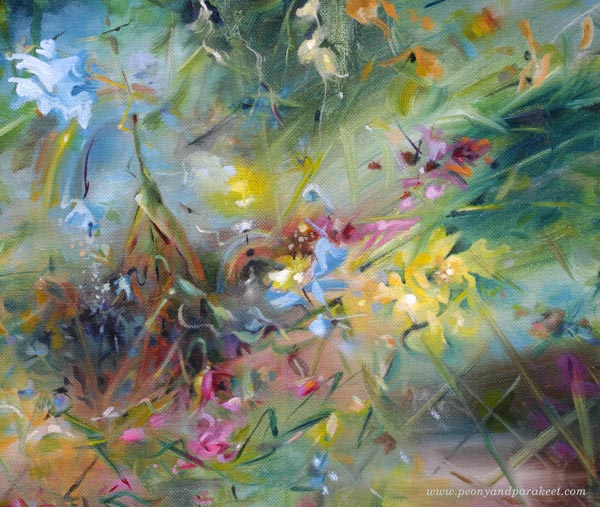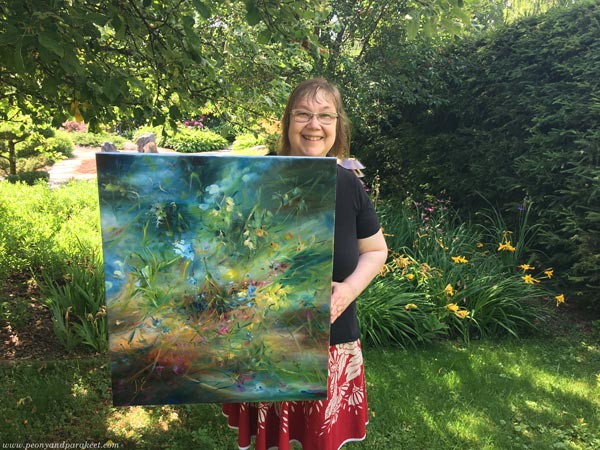Five Tips for Painting Nature’s Richness
This blog post is for you who want to create less stiff and more abstract art. First, I suggest rephrasing your goal. Say you want to get closer to nature – to paint nature’s richness!

In this painting, flowers fly recklessly in every direction. This kind of disorder is part of nature’s richness. I used to think that it could be achieved by quickly throwing paint here and there, but I am much more successful when I create these beautiful messes in an orderly way.
Experiencing Nature’s Richness
Although I live in a big town, there is a cornfield in our neighborhood. I often walk along the path that goes by it. In August 2020, I was walking with my dog Stella. When I reached the beginning of the trail, I was greeted by a magical sight. The surroundings of the path were full of butterflies!

I tried to take photos, but only close-ups were successful. Butterflies are such small and fast insects that they cannot be distinguished from a distance, even if there are many of them.

But the experience stuck in my mind. Now, years later, I wanted to capture it but in a bit different setting. I wanted to depict a situation where someone would throw a bouquet of flowers in the air and they would magically start flying in the air like butterflies.
Working in Layers
I started the painting by making a background for it. I painted a grid in the style of Paul Klee. I teach this beginning technique in the course Floral Freedom.

I then started to create nature’s richness on top of the grid with brushstrokes. I added flying flowers several times and dried every layer before starting a new one.
Taking Photos for Inspiration
I often take photos of plants and nature scenery. Even Claude Monet has said: “The richness I achieve comes from nature, the source of my inspiration.” I don’t use the photos as references but for teaching myself nature’s language. I examine an image to see nature’s richness, for example, the shapes that light throws and all the variation there is if you forget what the image represents.
Take a look at this flower bouquet I put together for Midsummer: the flowers consist of several layers and have differences in size and shape.

Think about one flower as a collection of strokes that form motifs.
Five Tips for Painting Nature’s Richness
When you add motifs on the background, remember nature’s richness and do otherwise than what you are used to:
- Don’t cover it all over again! Create a sense of depth by covering the previous layer only partly. This way, every layer has fewer motifs than the previous one. Paint the first motifs with muted tones and slowly introduce stronger colors.
- Don’t repeat the same thing! Get natural variation by painting many different repeating motifs. Change the sizes and distances of similar motifs so that they look more irregular. Use many brushes and think about every stroke as a word. How rich is your language?
- Don’t design fabric but tell a story! Make an expressive image, not only a surface pattern. Despite the chaos, make one area stand out. Make this focal point stronger by adjusting some other distinctive motifs so that they clearly point to it. Avoid spreading white spots everywhere. They distract the viewer and make the painting flat.
- Don’t leave your motifs lonely! Bring more unity by connecting motifs together. You can use lines, intersections, and surrounding space. Think about the painting as a collection of mini landscapes.
- Don’t hurry! Give your painting time to grow. Take breaks and keep your painting somewhere where you can observe it. You have probably already tried many times to paint quickly, now choose another way and slowly immerse yourself in the painting.

In this orderly way, the painting begins to look more and more finished naturally.

At the last layer, it takes some courage to paint larger and brighter motifs on top of smaller and more muted ones.
Nature’s Richness – Expressing Mortality in Immortal
A part of nature’s richness is to allow some flowers to fall and die, and some rise and fly. Dark colors, sad strokes, and downward lines all give power to the bright and happy ones. You can take your piece outdoors and see if it’s one with the surroundings. My course Floral Freedom is packed with techniques and further ideas.

This painting “Immortal Bouquet” tells about the hopeless desire to live forever but also about the fact that life does continue when thinking about nature. An immortal bouquet is an unreal wish for the one who gathers the flowers, but on the other hand, it’s also true: flowers are reborn in nature every year.
What do you think?
12 thoughts on “Five Tips for Painting Nature’s Richness”
Comments are closed.
Amazing gorgeous work.
Thank you, Ronna!
Your paintings burst with energy, color and excitement. I absolutely love each and every one. I am going to try your techniques and hope they turn out half as good as yours! Thank you for sharing your talent.
Thanks so much, Vada!
That is Fantastic Paivi! Thank you!
I am re-inspired😍
Thank you, Cassie! Keep creating!
This looks like so much fun. I am working at the moment so I didn’t read every word but I will later. You know what I would like to see? Perhaps it already exists or maybe it’s something you hold close to the vest….blah blah anyway, I would love to see you painting in action. To see how you get those beautiful, unique strokes. I am picturing how it’s done and I’ll definitely give it a try. I love that you love nature so much I do too and I need to get out there and boost my motivation and creativity. I appreciate you showing us your work and suggestions I will definitely try. Have a great day sweetie. Love your puppy too!!
Thank you, Jeanine! In general, I have a lot of videos (see the videos category of the blog https://www.peonyandparakeet.com/category/videos/) and online classes with more comprehensive videos (https://www.peonyandparakeet.com/shop/)
I often make a quick stroke first and then make it more finished with very slow and thoughtful adjustments. In many classes, I talk about how I have practiced my strokes!
Hi Paivi,
Thanks for the free advice. I enjoy the theory behind your artwork as much as the paintings. Inspiring!
Thank you, Jane!
I agree wholeheartedly with Jane’s comment: your theory behind your paintings are what excite me much like an epiphany!! Thanks so much. and: your new painting is just gorgeous.
Thank you, Alice!